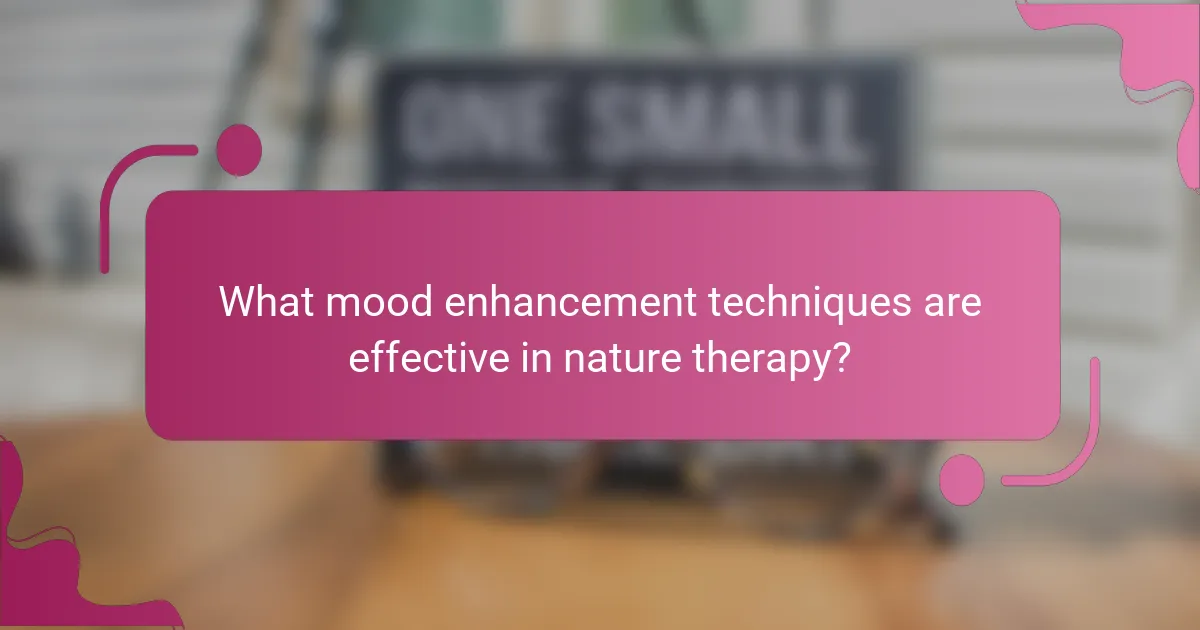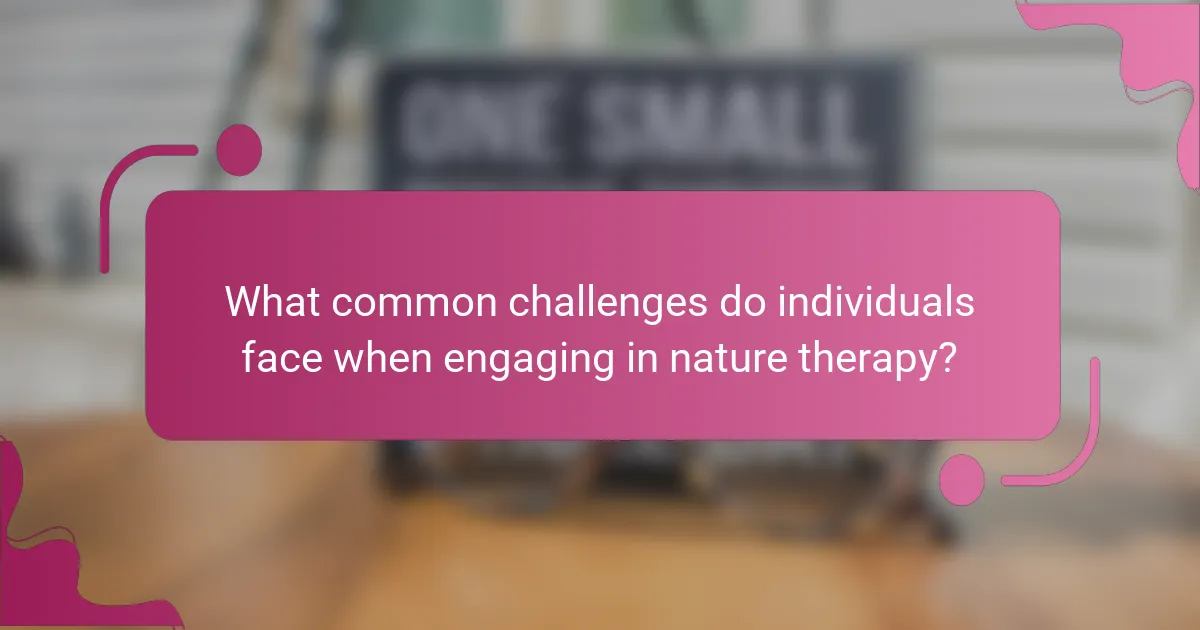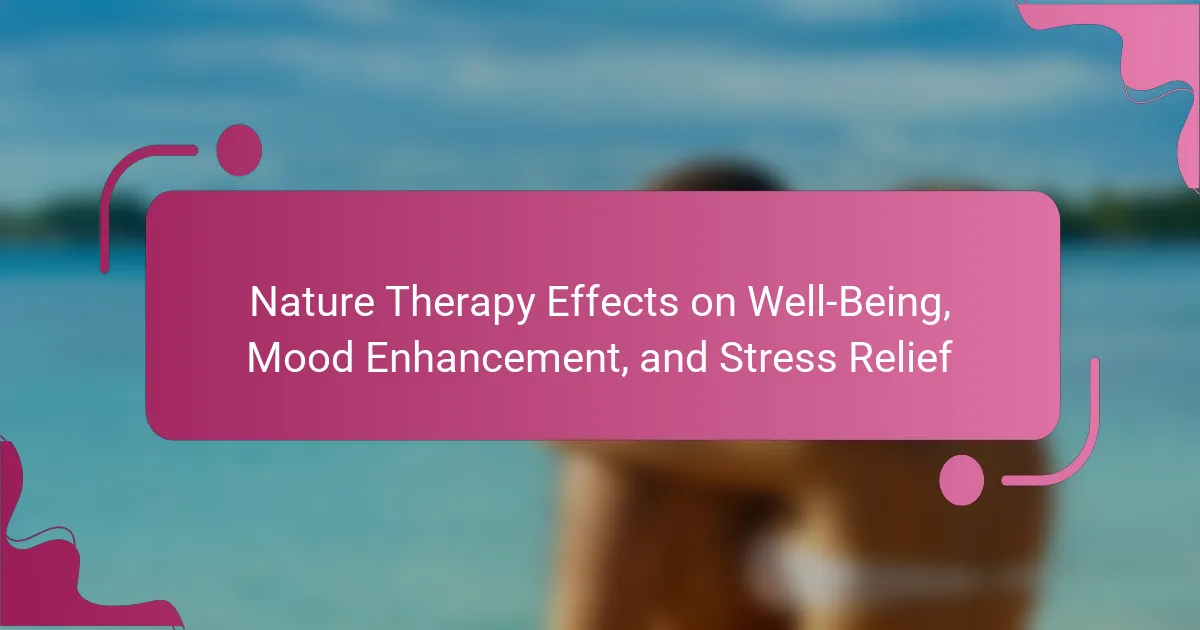Nature therapy significantly enhances well-being by improving mood and relieving stress. It promotes mindfulness, encourages physical activity, and fosters social connections. Engaging with natural environments lowers cortisol levels and boosts happiness. Unique practices like forest bathing and ecotherapy further deepen the benefits of this therapeutic approach.

How does nature therapy enhance overall well-being?
Nature therapy significantly enhances overall well-being by promoting mood enhancement and stress relief. Engaging with nature reduces cortisol levels, leading to lower stress and anxiety. Studies indicate that spending time outdoors improves mood and increases feelings of happiness. Nature therapy encourages physical activity, which contributes to better mental health. Additionally, exposure to natural environments fosters mindfulness, enhancing emotional resilience.
What psychological benefits are associated with nature therapy?
Nature therapy enhances psychological well-being by improving mood and relieving stress. Engaging with nature reduces anxiety and depression symptoms, fostering a sense of calm and connection. Studies show that even brief exposure to natural environments can elevate mood and promote relaxation, leading to improved mental health outcomes. Nature therapy also encourages mindfulness, which contributes to greater emotional resilience.
How does exposure to nature affect physical health?
Exposure to nature significantly enhances physical health by reducing stress, improving mood, and promoting overall well-being. Nature therapy has been shown to lower cortisol levels, which are linked to stress, and improve cardiovascular health through increased physical activity. Studies indicate that spending time in green spaces can lead to lower rates of anxiety and depression. Furthermore, nature exposure encourages social interactions, which contribute to emotional resilience. Engaging with natural environments can also enhance immune function, leading to better health outcomes.

What mood enhancement techniques are effective in nature therapy?
Nature therapy enhances mood through techniques like mindfulness, physical activity, and sensory engagement. These methods promote relaxation and emotional well-being.
Mindfulness practices in nature, such as meditation or deep breathing, help reduce anxiety and improve mood. Engaging in physical activities like hiking or gardening releases endorphins, boosting happiness. Sensory engagement, including observing natural beauty or listening to natural sounds, fosters a sense of connection and tranquility.
Research indicates that spending time in nature can lower cortisol levels, a stress hormone, contributing to overall mood enhancement. Nature therapy also encourages social interaction, which can further uplift mood and reduce feelings of isolation.
Which sensory experiences contribute to mood improvement?
Nature therapy enhances mood through sensory experiences such as sight, sound, and smell. Visual stimuli from greenery and landscapes promote relaxation. Natural sounds, like birdsong and flowing water, reduce stress levels. Aromatic plants contribute to emotional well-being by triggering positive memories. Engaging with these sensory elements fosters a sense of connection to nature, improving overall mental health and mood.
How do seasonal changes influence mood in nature therapy?
Seasonal changes significantly influence mood in nature therapy by enhancing emotional well-being. Different seasons offer unique sensory experiences that can elevate mood and reduce stress. For instance, spring’s blooming flowers can invigorate feelings of joy, while autumn’s vibrant foliage can instill a sense of peace. Research indicates that exposure to natural environments during these seasonal shifts can lead to improved mental health outcomes. Engaging with nature throughout the year helps individuals adapt to changes and fosters resilience against mood fluctuations.

What are the key stress relief mechanisms of nature therapy?
Nature therapy effectively reduces stress through mechanisms such as exposure to natural environments, physical activity, and mindfulness practices. These elements enhance mood and promote overall well-being.
Exposure to nature lowers cortisol levels, the hormone associated with stress. Studies indicate that spending time in green spaces can significantly improve mental health outcomes. Physical activities like hiking or gardening provide exercise, which releases endorphins, further alleviating stress. Mindfulness practices, often incorporated in nature therapy, foster present-moment awareness, reducing anxiety and enhancing emotional regulation.
Engagement with nature promotes social connections, which are vital for emotional support. Participating in group activities outdoors can strengthen relationships and create a sense of belonging. Nature therapy also encourages a break from technology, allowing individuals to recharge mentally and emotionally.
In summary, nature therapy’s multifaceted approach to stress relief combines environmental exposure, physical activity, mindfulness, and social engagement, leading to improved mood and well-being.
How does nature therapy lower cortisol levels?
Nature therapy effectively lowers cortisol levels by promoting relaxation and reducing stress. Exposure to natural environments enhances mood and encourages mindfulness, which contributes to lower stress hormones. Studies show that spending time in nature can decrease cortisol levels by up to 20%. Engaging in activities like walking in parks or forest bathing fosters a sense of calm, further aiding stress relief. This holistic approach not only improves mental well-being but also supports physical health by mitigating the effects of chronic stress.
What role does mindfulness play in nature therapy for stress relief?
Mindfulness significantly enhances the effectiveness of nature therapy for stress relief. It fosters present-moment awareness, allowing individuals to connect deeply with their surroundings. This connection can lead to reduced anxiety and improved mood. Studies show that integrating mindfulness practices during nature therapy sessions amplifies the benefits, promoting emotional resilience and overall well-being. Engaging with nature mindfully can lower cortisol levels, contributing to stress reduction.

Which unique nature therapy practices are gaining popularity?
Unique nature therapy practices gaining popularity include forest bathing, ecotherapy, and nature meditation. These practices enhance well-being by fostering a deeper connection with nature, improving mood, and providing effective stress relief.
Forest bathing, originating from Japan, encourages immersion in natural environments, promoting relaxation and mental clarity. Ecotherapy integrates nature into therapeutic practices, offering healing through outdoor activities and nature-based interventions. Nature meditation combines mindfulness with natural settings, enhancing emotional resilience and reducing anxiety.
These approaches emphasize the unique attribute of engaging with the environment to cultivate mental health benefits. As a result, they are increasingly recognized as effective methods for improving overall well-being.
How do forest bathing and ecotherapy differ?
Forest bathing and ecotherapy differ primarily in their focus and practice. Forest bathing emphasizes immersion in nature for sensory experiences, promoting relaxation and mindfulness. Ecotherapy incorporates therapeutic practices, often guided by a professional, to address mental health issues through nature engagement.
Forest bathing enhances well-being through direct sensory experiences, while ecotherapy aims for structured healing, addressing specific psychological needs. Both approaches share benefits like stress relief and mood enhancement, but their methodologies and goals distinguish them.
What innovative approaches are being used in urban settings?
Innovative approaches in urban settings utilize nature therapy to enhance well-being, improve mood, and relieve stress. Urban green spaces, such as parks and community gardens, provide accessible environments for nature therapy. Research indicates that spending time in these areas can reduce cortisol levels, leading to lower stress. Programs integrating nature therapy into urban planning promote mental health, fostering community connections and resilience. Furthermore, initiatives like urban forestation and green roofs contribute to biodiversity, enhancing the overall quality of life in cities.

How can nature therapy be integrated into daily life?
Integrating nature therapy into daily life enhances well-being, mood, and stress relief. Incorporate outdoor activities, such as walking in parks or gardening, into your routine. Schedule regular time in natural settings to recharge mentally and emotionally. Use nature sounds or visuals at home or work to create a calming environment. Engage in mindfulness practices outdoors to deepen your connection with nature.
What are some simple nature therapy activities to try?
Engaging in nature therapy activities can significantly enhance well-being, mood, and relieve stress. Here are some simple activities to try:
1. Nature Walks: Spend time walking in parks or forests to connect with natural surroundings.
2. Gardening: Cultivate plants or flowers, which promotes mindfulness and relaxation.
3. Mindful Observation: Sit quietly outdoors and focus on the sights, sounds, and smells of nature.
4. Forest Bathing: Immerse yourself in a forest environment to reduce anxiety and improve mood.
5. Nature Journaling: Document your experiences and feelings while in nature to enhance emotional awareness.
6. Outdoor Meditation: Practice meditation in a natural setting to deepen relaxation and clarity.
How can workplaces implement nature therapy for employee wellness?
Workplaces can implement nature therapy by integrating green spaces, promoting outdoor activities, and encouraging nature-based mindfulness practices. These initiatives enhance employee well-being, improve mood, and reduce stress.
Research shows that exposure to nature can lead to a 20% increase in overall well-being. Incorporating elements such as plants in the office or organizing nature walks fosters a calming environment. Nature therapy also boosts creativity and productivity, making it a valuable investment for organizations.
Additionally, companies can provide workshops on nature-based mindfulness techniques, helping employees connect with their surroundings. These practices can lower anxiety levels and create a more engaged workforce.
By prioritizing nature therapy, workplaces can cultivate a healthier atmosphere that supports mental health and enhances job satisfaction.

What common challenges do individuals face when engaging in nature therapy?
Individuals often face challenges such as accessibility to natural spaces, weather conditions, and lack of guidance when engaging in nature therapy. These obstacles can hinder the potential benefits of improved well-being, mood enhancement, and stress relief. For example, limited access to green areas can reduce participation, while adverse weather may deter outdoor activities. Additionally, individuals may struggle to find qualified facilitators who can effectively guide them through nature therapy experiences.
How can accessibility issues impact participation in nature therapy?
Accessibility issues can significantly hinder participation in nature therapy. Physical barriers, such as uneven terrain or lack of pathways, limit access for individuals with mobility challenges. Additionally, sensory impairments can restrict engagement with natural environments, affecting mood enhancement and stress relief. Social factors, like stigma or lack of awareness, further deter participation. Ensuring inclusive access promotes well-being for all individuals, enhancing the therapeutic benefits of nature therapy.
What misconceptions about nature therapy need to be addressed?
Many misconceptions about nature therapy suggest it lacks scientific backing or effectiveness. In reality, research indicates that nature therapy significantly enhances well-being, improves mood, and reduces stress. For instance, studies reveal that spending time in natural environments can lower cortisol levels, a key stress hormone. Additionally, some believe nature therapy is only beneficial for mental health, overlooking its positive impacts on physical health, such as improved cardiovascular function. Addressing these misconceptions can foster greater acceptance and utilization of nature therapy as a valuable resource for holistic health.
What practical tips can enhance the effectiveness of nature therapy?
Engaging in nature therapy can be enhanced by incorporating specific practical tips. Spend time in diverse natural settings to maximize mood enhancement and stress relief. Regularly practice mindfulness during outdoor activities to deepen relaxation. Establish a routine that includes nature walks or gardening to foster consistent benefits. Engage in physical activities like hiking or yoga in nature to boost overall well-being.
